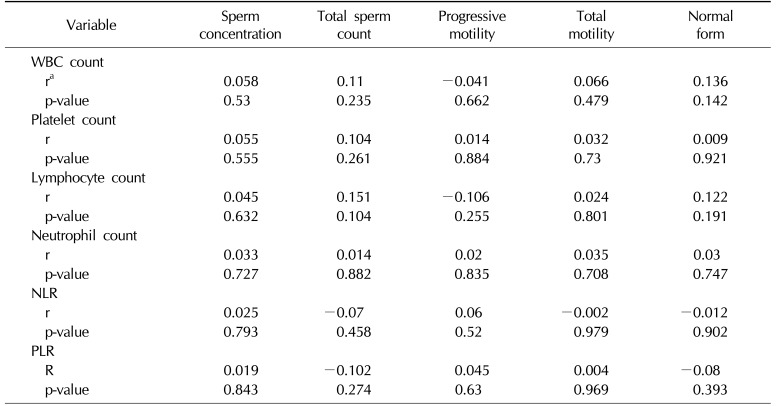1. Aston KI, Krausz C, Laface I, Ruiz-Castané E, Carrell DT. Evaluation of 172 candidate polymorphisms for association with oligozoospermia or azoospermia in a large cohort of men of European descent. Hum Reprod. 2010; 25:1383–1397. PMID:
20378615.

2. Fraczek M, Kurpisz M. Cytokines in the male reproductive tract and their role in infertility disorders. J Reprod Immunol. 2015; 108:98–104. PMID:
25796532.

3. Hamada A, Esteves SC, Nizza M, Agarwal A. Unexplained male infertility: diagnosis and management. Int Braz J Urol. 2012; 38:576–594. PMID:
23131516.

4. Zahorec R. Ratio of neutrophil to lymphocyte counts: rapid and simple parameter of systemic inflammation and stress in critically ill. Bratisl Lek Listy. 2001; 102:5–14. PMID:
11723675.
5. Celikbilek M, Dogan S, Ozbakır O, Zararsız G, Kücük H, Gürsoy S, et al. Neutrophil-lymphocyte ratio as a predictor of disease severity in ulcerative colitis. J Clin Lab Anal. 2013; 27:72–76. PMID:
23292894.

6. Kurtul BE, Ozer PA. The relationship between neutrophil-to-lymphocyte ratio and age-related macular degeneration. Korean J Ophthalmol. 2016; 30:377–381. PMID:
27729758.

7. Duksal F, Alaygut D, Güven AS, Ekici M, Oflaz MB, Tuncer R, et al. Neutrophil-lymphocyte ratio in children with familial Mediterranean fever: original article. Eur J Rheumatol. 2015; 2:20–23. PMID:
27708915.

8. Imtiaz F, Shafique K, Mirza SS, Ayoob Z, Vart P, Rao S. Neutrophil lymphocyte ratio as a measure of systemic inflammation in prevalent chronic diseases in Asian population. Int Arch Med. 2012; 5:2. PMID:
22281066.

9. World Health Organization (WHO). WHO Laboratory manual for the examination and processing of human semen. 5th ed. Geneva: WHO Department of Reproductive Health and Research;2010.
10. Politch JA, Tucker L, Bowman FP, Anderson DJ. Concentrations and significance of cytokines and other immunologic factors in semen of healthy fertile men. Hum Reprod. 2007; 22:2928–2935. PMID:
17855405.

11. Lampiao F, du Plessis SS. TNF-alpha and IL-6 affect human sperm function by elevating nitric oxide production. Reprod Biomed Online. 2008; 17:628–631. PMID:
18983746.
12. Zhang H, Yin Y, Wang G, Liu Z, Liu L, Sun F. Interleukin-6 disrupts blood-testis barrier through inhibiting protein degradation or activating phosphorylated ERK in Sertoli cells. Sci Rep. 2014; 4:4260. PMID:
24584780.

13. Zalata A, Atwa A, El-Naser Badawy A, Aziz A, El-Baz R, Elhanbly S, et al. Tumor necrosis factor-α gene polymorphism relationship to seminal variables in infertile men. Urology. 2013; 81:962–966. PMID:
23465534.

14. Hermosilla C, Caro TM, Silva LM, Ruiz A, Taubert A. The intriguing host innate immune response: novel anti-parasitic defence by neutrophil extracellular traps. Parasitology. 2014; 141:1489–1498. PMID:
24721985.

15. Hales DB. Testicular macrophage modulation of Leydig cell steroidogenesis. J Reprod Immunol. 2002; 57:3–18. PMID:
12385830.

16. Yoon NB, Son C, Um SJ. Role of the neutrophil-lymphocyte count ratio in the differential diagnosis between pulmonary tuberculosis and bacterial community-acquired pneumonia. Ann Lab Med. 2013; 33:105–110. PMID:
23482854.

17. Wang GY, Yang Y, Li H, Zhang J, Jiang N, Li MR, et al. A scoring model based on neutrophil to lymphocyte ratio predicts recurrence of HBV-associated hepatocellular carcinoma after liver transplantation. PLoS One. 2011; 6:e25295. PMID:
21966488.

18. Kaya H, Ertaş F, İslamoğlu Y, Kaya Z, Atılgan ZA, Çil H, et al. Association between neutrophil to lymphocyte ratio and severity of coronary artery disease. Clin Appl Thromb Hemost. 2014; 20:50–54. PMID:
22790659.

19. Sunbul M, Gerin F, Durmus E, Kivrak T, Sari I, Tigen K, et al. Neutrophil to lymphocyte and platelet to lymphocyte ratio in patients with dipper versus non-dipper hypertension. Clin Exp Hypertens. 2014; 36:217–221. PMID:
23786430.

20. Liu CL, Lee JJ, Liu TP, Chang YC, Hsu YC, Cheng SP. Blood neutrophil-to-lymphocyte ratio correlates with tumor size in patients with differentiated thyroid cancer. J Surg Oncol. 2013; 107:493–497. PMID:
22996403.

21. Yao Y, Yuan D, Liu H, Gu X, Song Y. Pretreatment neutrophil to lymphocyte ratio is associated with response to therapy and prognosis of advanced non-small cell lung cancer patients treated with first-line platinum-based chemotherapy. Cancer Immunol Immunother. 2013; 62:471–479. PMID:
22986452.

22. Feng JF, Huang Y, Zhao Q, Chen QX. Clinical significance of preoperative neutrophil lymphocyte ratio versus platelet lymphocyte ratio in patients with small cell carcinoma of the esophagus. ScientificWorldJournal. 2013; DOI:
10.1155/2013/504365.

23. Miglani RK, Bhateja N, Bhat RS, Kumar KV. Diagnostic role of platelet lymphocyte ratio (PLR) in pancreatic head masses. Indian J Surg. 2013; 75:4–9. PMID:
24426375.
24. Lewis SE. Is sperm evaluation useful in predicting human fertility? Reproduction. 2007; 134:31–40. PMID:
17641086.








 PDF
PDF ePub
ePub Citation
Citation Print
Print


 XML Download
XML Download